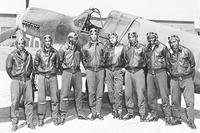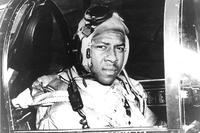In 1942, Maj. Arthur Wermuth was crawling through mud to avoid a Japanese patrol marching through the jungle. The invaders had no idea he was there. When they passed, he continued crawling on the jungle floor.
His destination was a ridgeline that overlooked the nearby enemy camp. He climbed to the top of the ridge and drew out his Thompson submachine gun. He then let loose on the encampment. The Japanese, now confused and panicking, thought the Americans had slipped into their rear.
But it was only Wermuth, the “One-Man Army of Bataan.”
Just nine hours after Japan’s surprise attack on Pearl Harbor, the Imperial Japanese Navy launched an invasion of the Philippines. But the Philippines didn’t go easily into Japanese hands.
Standing in their way were thousands of Philippine Scouts, led by seasoned officers like Wermuth. The scouts were professional Filipino soldiers, specially trained to fight and subdue rebels in the jungle terrain, slip through enemy lines to gather intelligence and perform devastating hit-and-run attacks.
Japan had launched near simultaneous invasions of Hong Kong, Wake Island, Guam, Malaya, Singapore and Thailand. Within three months, the Japanese war machine had overrun every Pacific nation and island in the region, with the exception of the Philippines.
Among the 22,000 defenders of the islands in the early days of the war were more than 10,000 Philippine Scouts. Wermuth was the commander of the scouts’ 57th Infantry Regiment. They would prove to be the biggest advantage for the American defenders of the island. Growing up as a ranch hand and son of a World War I veteran, Wermuth almost was destined to be a soldier.
He attended Northwestern Military Academy in Wisconsin and was an outstanding athlete. He joined the Army in 1936 and was sent to the Philippines as the United States rushed to build its armed forces in preparation for the war.
But when the Japanese attack came, the island nation wasn’t fully prepared for the expert soldiers who would land there. Much of the island was filled with non-combat troops, guardsmen and Filipino reservists.
Overwhelmed by enemy air power, the defenders fell back to reinforced defensive positions in the Bataan Peninsula. To get there, they had to hold the Japanese advance from a series of fortified positions.
The Philippine Scouts 26th Cavalry rode to fight the invaders, then manned the series of defensive positions as they withdrew. Once the defenders were on the peninsula, the scouts blew up the bridges.
Bataan would not surrender until April 1942, and until it did, Maj. Wermuth would take every opportunity to give the Japanese a bloody nose, black eye or any other wound he could inflict. If ever there was a World War II officer we could compare to a real-life “Rambo,” Wermuth was it.
In January 1942, the Japanese began their attacks on Bataan in earnest. Wermuth picked up his Thompson submachine gun, two pistols and a handful of grenades. He walked into the jungle looking for the attackers. He hid in the jungle until Japanese troops walked by him, then shadowed their movements to the front line.

Wermuth followed the Japanese force for miles, and right before they were able to attack his camp, he pulled the pin on a grenade and tossed it toward the enemy troops. It went off, alerting the Philippine Scouts that the enemy was near. As the Filipino soldiers fired into the Japanese, Wermuth fired into their flank and annihilated them.
The Army officer became known to the Japanese as “The Ghost of Bataan” as his infiltrate-and-kill missions became bolder and bolder.
By Jan. 11, 1942, the Japanese had pushed the Americans south past the Abucay Line near the city of Kalaguiman. The only way they could slow the advance was to destroy the bridge north of the city. Wermuth volunteered to go by himself. He carried his trademark Thompson and two pistols along with two five-gallon jugs of gasoline. The gasoline wasn’t meant for the bridge, however.
The plan called for Wermuth to enter the town and set a fire. When the smoke was visible, Filipino artillery would open up on Kalaguiman. The shelling would distract the Japanese long enough for Wermuth to set the charges and detonate the bridge.
The American officer made his way silently through the entire city, but instead of just starting a fire, he doused the huts of sleeping enemy soldiers and lit them with a match. Japanese troops soon poured out. Those who weren’t on fire began looking for the arsonist. Wermuth made a break for the bridge.
A hail of gunfire greeted his arrival at the bridge. Wermuth was shot in the leg but continued his dash to set the charges. As he began to work on the bridge, artillery began to rain down on Kalaguiman, giving him enough time and distraction to do the job. He then made a very slow beeline, through the sniper-infested jungles, for friendly lines.
Wermouth was shot in the chest during a near-suicide mission, an effort to retake Mount Pucat from the Japanese. The bullet went through his lung, and he was forced into the hospital. After little more than a week, he attempted to rejoin the scouts, but fell into a ravine and was hospitalized again. The Americans surrendered in April 1942 while he was recovering. But he was too injured to be forced on the Bataan Death March that 60,000 to 80,000 other American soldiers would endure.
He spent the rest of the war as a prisoner, finally liberated by the Soviet Red Army in Mukden, China, in August 1945. He credited his success in the fighting to his Filipino soldiers.
“Ninety percent of the credit for what I did was due to them,” he told Montana’s Billings Gazette. “They're the best soldiers in the world. I just happened to be in the right place at the right time."
-- Blake Stilwell can be reached at blake.stilwell@military.com. He can also be found on Twitter @blakestilwell or on Facebook.
Want to Learn More About Military Life?
Whether you're thinking of joining the military, looking for post-military careers or keeping up with military life and benefits, Military.com has you covered. Subscribe to Military.com to have military news, updates and resources delivered directly to your inbox.
















